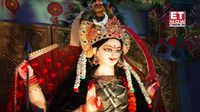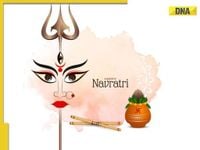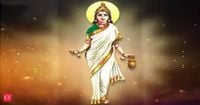Chaitra Navratri, a revered nine-day Hindu festival, begins on March 30, 2025, and is celebrated with great fervor across India. This festival not only marks the arrival of spring but also signifies the triumph of good over evil and the divine power of Goddess Durga. Each day of Navratri is dedicated to a different form of the Goddess, with devotees engaging in various rituals, prayers, and fasting.
The second day of Chaitra Navratri, which falls on March 31, 2025, is dedicated to the worship of Maa Brahmacharini. This day holds immense spiritual significance as it honors the goddess who embodies perseverance, wisdom, and devotion. The name "Brahmacharini" signifies a follower of Brahma (the ultimate truth) and one who walks the path of self-discipline and spiritual wisdom.
Maa Brahmacharini is depicted as a serene figure dressed in a white saree, symbolizing purity and chastity. In her right hand, she holds a rosary (Japamala), representing meditation and devotion, while her left hand carries a water pot (Kamandalu), symbolizing simplicity and self-restraint. According to Hindu mythology, Goddess Parvati took this form to perform intense penance (Tapasya) to win the love of Lord Shiva. Her unwavering dedication and ascetic practices earned her the name Brahmacharini.
Devotees observe a fast on this day, seeking blessings for strength, wisdom, and peace. The auspicious color for Day 2 is white, representing peace and spiritual enlightenment. Wearing white on this day is believed to attract Maa Brahmacharini’s blessings and bring inner calmness. Rituals typically include cleaning the puja space, placing an idol or image of the goddess, lighting a diya (oil lamp), and offering fruits, sweets, and milk-based prasad as symbols of devotion.
Chaitra Navratri is not just a spiritual observance; it is also a time for cultural celebration and community bonding. In Maharashtra, the festival begins with Gudi Padwa, while in Andhra Pradesh and Karnataka, it coincides with Ugadi, marking the Hindu New Year. The festival is celebrated with vibrant rituals, including traditional dances, music, and communal feasts.
One of the unique aspects of Chaitra Navratri is the custom of wearing specific colors each day, with each color representing different virtues, qualities, and blessings associated with the Goddess. This tradition enhances the festive spirit and deepens devotees' connection with the divine. The first day of Chaitra Navratri, which begins on March 30, 2025, is dedicated to Goddess Shailputri, who symbolizes purity and nature. Devotees wear orange on this day to invoke her blessings for energy and positivity.
The color scheme for Chaitra Navratri 2025 is as follows:
- Day 1 (March 30, 2025): Orange – Symbolizing warmth, energy, and positivity, connected to Goddess Shailputri.
- Day 2 (March 31, 2025): White – Symbolizing purity and tranquility, representing Goddess Brahmacharini.
- Day 3 (April 1, 2025): Sky Blue – Representing peace and courage, associated with Goddess Chandraghanta.
- Day 4 (April 2, 2025): Orange – Honoring Goddess Kushmanda, symbolizing vitality and joy.
- Day 5 (April 3, 2025): Green – Reflecting harmony and renewal, dedicated to Goddess Skandamata.
- Day 6 (April 4, 2025): Red – Representing passion and courage, honoring Goddess Katyayani.
- Day 7 (April 5, 2025): Royal Blue – Symbolizing mystery and transformation, dedicated to Goddess Kalaratri.
- Day 8 (April 6, 2025): Magenta Pink – Representing grace and beauty, associated with Goddess Mahagauri.
- Day 9 (April 7, 2025): Purple – Symbolizing spiritual awakening and fulfillment, dedicated to Goddess Siddhidatri.
Each day's color not only amplifies the festive spirit but also resonates with the qualities of the respective Goddess being worshiped. This practice fosters a deeper spiritual connection among devotees and enhances their experience of the festival.
As Chaitra Navratri unfolds, devotees engage in a variety of practices, including fasting, prayer, and cultural celebrations. The festival offers a unique opportunity to embrace spirituality, culture, and tradition. Whether through rituals, wearing traditional attire, or sharing festive meals with loved ones, each individual finds their own way to honor the Goddess and partake in the joyous atmosphere.
The significance of Chaitra Navratri extends beyond mere rituals; it embodies the spirit of renewal, devotion, and community. It serves as a reminder of the eternal battle between good and evil, represented through the story of Goddess Durga and her victory over the demon Mahishasura. This narrative emphasizes the importance of resilience, strength, and faith in overcoming life's challenges.
In summary, Chaitra Navratri is a vibrant celebration that encapsulates the essence of devotion, cultural richness, and spiritual awakening. As the festival progresses, devotees are encouraged to immerse themselves in its traditions, seek the blessings of the Goddess, and foster a sense of unity and joy within their communities.








